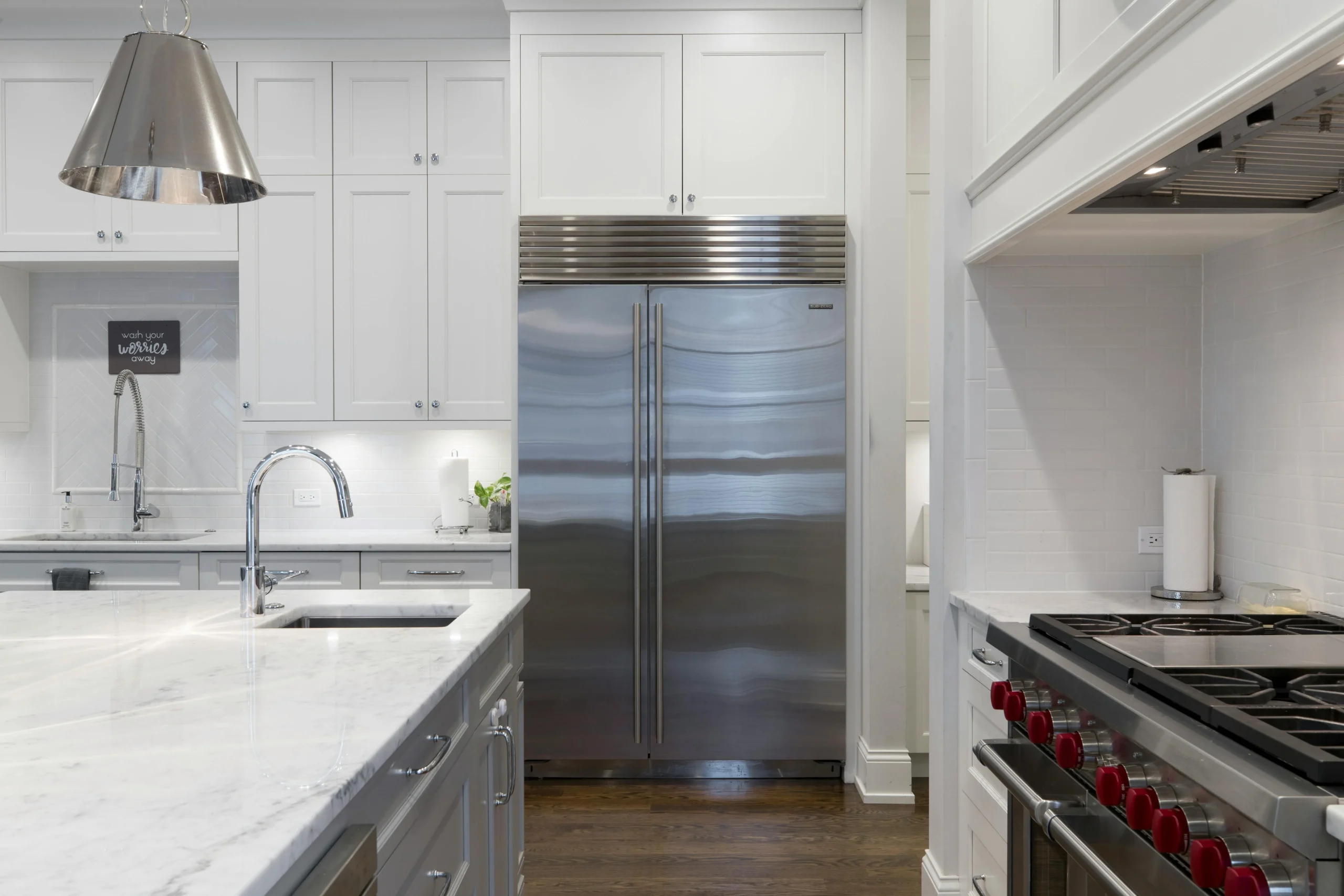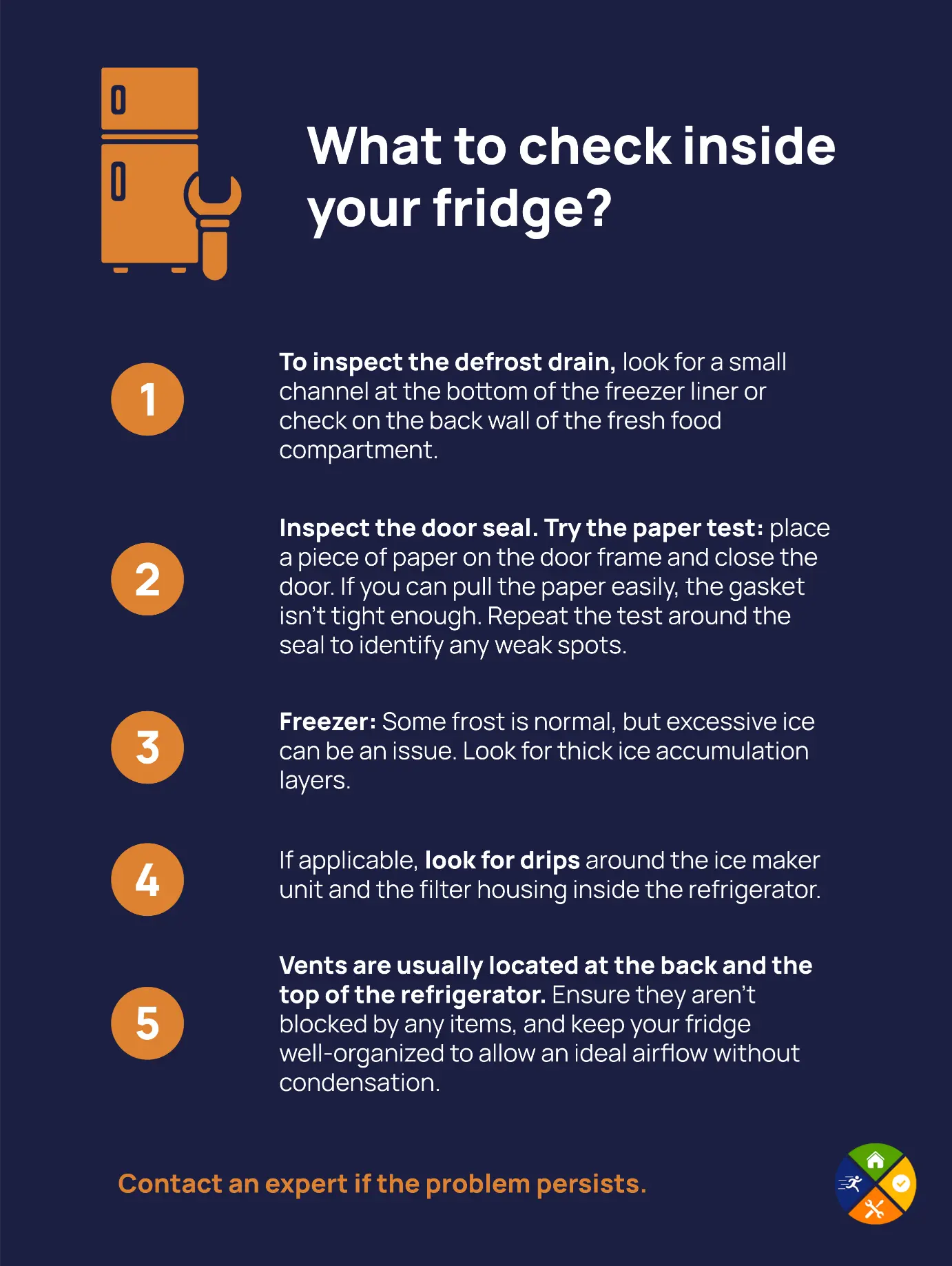
Have you found messy puddles inside or underneath your fridge? Some common causes include blocked drains or vents, faulty door seals or gaskets, overpacking, damaged or clogged internal devices, and excessive frost buildup.
You might worry that the appliance isn’t working properly and your groceries will spoil. And, with so many probable causes, we understand that dealing with a leaking problem may be frustrating.
However, identifying the cause is simple if you pay attention. Here’s a comprehensive guide to understanding why there’s water coming out of your refrigerator.
How to identify if the leak is coming from underneath?
If a puddle forms in front of your fridge, the first thing to do is to spot where it is coming from. Pay attention, but don’t panic. Leaks are common and often fixable. Be patient and observe to confirm that the water comes from underneath the appliance:
- Pay attention to details: Is it a large puddle, or are you dealing with drips? Check if the pool is directly under the center, or in front of the fridge, off to one side, or if it extends to the back. How does the water look? Is it clear or oily water? Does it have a distinct color or smell?
- Dry thoroughly: Wipe up the water from the floor using towels, paper towels, or a mop. Create a dry environment around and under the appliance to monitor the formation of new puddles. Dry the surrounding floor in case the water starts spreading.
- Prepare for observation: Place highly absorbent materials such as paper towels, newspaper, or thin cardboard under the front of the fridge and extend them as back as you can slide them. When the water starts leaking again, these surfaces will give you clues about where it is coming from.
- Monitor: Check frequently. Start with short intervals of 30 minutes or an hour. If no water appears, check every few hours or after a night’s sleep.
- If no drips are coming from the door seals, the dispenser, or the top, and water is still appearing under the fridge, then you can confirm that the leak is coming from underneath the refrigerator.
Why is my refrigerator leaking water inside?

Finding soaked milk cartons or puddles on shelves and containers inside your refrigerator can be a problem. Here’s some information to help you understand why unwanted pools are forming in your fridge.
Common reasons for internal water leaks
- Blocked defrost drain: This is one of the most frequent reasons because your fridge has internal water leaks. During the defrost cycle, the accumulated ice melts into water.
That water drains through a small tube at the bottom of the freezer into a pan under the appliance, where it should evaporate. If the drain has dirt, food particles, ice, or mold buildup, water can’t get through and it backs up. Over time, this overflows the tube and pools inside the refrigerator.
- Faulty door seals: A torn or worn-out gasket won’t seal properly, meaning that there’s probably more warm air entering the refrigerator than it should. This leads to condensation, which accumulates and causes puddles.
- Frost buildup: Broken door seals could also lead to frost buildup that transforms into puddles. During the defrost cycle, the excessive ice melts and may overflow the defrost drain.
- Water dispenser or ice maker: If your refrigerator has these features, check if components such as internal water lines, valves, and water filters are frozen or malfunctioning.
- Overpacking: When space is overpacked and vents are blocked, there’s no room for proper airflow. Overloading leads to more condensation than the system can handle, making droplets appear in the fridge.
What to check inside your fridge?
- To inspect the defrost drain, look for a small channel at the bottom of the freezer liner or check on the back wall of the fresh food compartment.
- Inspect the door seal. Try the paper test: place a piece of paper on the door frame and close the door. If you can pull the paper easily, the gasket isn’t tight enough. Repeat the test around the seal to identify any weak spots.
- Freezer: Some frost is normal, but excessive ice can be an issue. Look for thick ice accumulation layers.
- If applicable, look for drips around the ice maker unit and the filter housing inside the refrigerator.
- Vents are usually located at the back and the top of the refrigerator. Ensure they aren’t blocked by any items, and keep your fridge well-organized to allow an ideal airflow without condensation.
Why is my refrigerator leaking water on the floor?
External water leaks can be caused by issues that should be addressed to prevent risks and maintain the appliance’s lifespan. The most common causes are a broken drain pan, an overwhelmed drain line, or condensation.
However, there are other causes that you may identify that need to be addressed.
Causes for external leaks and water pooling on the floor
- Damaged drain pan: This component is a plastic tray placed at the back and the bottom of the refrigerator. It collects defrost water before it evaporates.
If the drain pan is cracked or broken, water leaks. In the presence of condensation or high humidity levels, water overflows the tray and leaks before evaporating.
- Clogged defrost drain: Drips originating inside the fridge can leak out of the refrigerator’s base.
- Faulty door seals: A broken gasket can lead to so much condensation thus the water eventually finds its way out onto the floor.
- For models with an ice maker or water dispenser: A cracked or loose water supply line or housing filter could be causing slow drips or leaks.
Safety and damage risks of floor leaks
A leaking refrigerator should be quickly addressed to prevent consequences and serious accidents. Here’s some information on how floor leaks cause damage and affect your safety:
- Electrical hazard: Water and electricity are a dangerous combination. If the water comes into contact with the fridge’s wiring or power cord, it can lead to a short circuit. If you step into a puddle that is in contact with an electrical current, you will suffer an electric shock.
- Falling hazards: A wet floor increases the risk of slipping and falling, especially in a busy area like the kitchen.
- Mold and mildew growth: Persistent leaks are the perfect environment for mold and mildew to grow. Even if you can’t see it, mold grows in hidden places (under the fridge or the flooring). The presence of these microorganisms can cause health issues like respiratory allergies and skin and eye irritation.
What does it mean when your refrigerator is leaking water?
When your refrigerator leaks water, it usually indicates an underlying issue rather than just an incident. It’s a signal of malfunction or blockage of the systems designed to handle drainage and water.
Interpretation of water leaks as signs of underlying issues
That leak in your refrigerator is asking for your attention, as it might indicate that something else is wrong with the appliance:
- Blockage: Something is obstructing the water flow where it should go. It commonly happens with food particles or debris in the drain tubes.
- Breach: A seal or tray is broken, allowing water to make its way out of the refrigerator (a damaged door seal or a cracked drain pan).
- Excessive humidity: Too much warm air entering the fridge, causing condensation and unwanted puddles.
- Malfunction: In the case of an appliance with an ice maker or water dispenser, components designed to handle water (like valves and filters) are failing.
Potential impacts on appliance health and food safety
Since water leaks are a sign that your refrigerator is compromised, not paying attention to the issue may affect appliance health and, most importantly, food safety and your well-being.
- Impacts on appliance health: If your refrigerator leaks, keep in mind that water can cause short circuits in wiring, motors, and the compressor. Also, water is highly corrosive and can rust metallic parts.
When there is a water leak from your fridge, the appliance is probably working harder to maintain its internal temperature, which means the compressor runs for longer periods.
Leaks create a wet environment inside and under the fridge for mold and mildew to grow, originating unpleasant odors and spreading to your groceries.
- Impacts on food safety: A leaking problem might indicate that the appliance is struggling to maintain the right temperature (due to a faulty gasket, condensation, or frost buildup).
Keeping the fridge chill enough is essential to preserve your food’s nutritional value and prevent bacteria and yeasts, which cause foodborne illnesses. Another aspect to consider is that if pooling water touches raw food or ready-to-eat groceries, it can cause cross-contamination.
How to fix your refrigerator water leak? — Contact OX Services for Professional Repair
Identifying and addressing water coming out of your fridge is essential not only to make sure your appliance works, but also to avoid any safety risks and preserve your health.
If you’re still dealing with a leaking refrigerator or don’t feel comfortable with DIY repairs, let the professionals handle it. At OX Services, our certified technicians are ready to check and repair your fridge or any other appliance.
Contact us and schedule your refrigerator repair service today!
